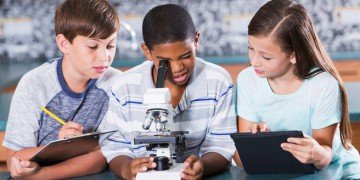Science isn’t just a body of knowledge — it’s a way of acquiring scientific concepts and principles, and the best elementary school programs get students interested in investigating the world around them. As children learn facts and vocabulary, they develop the ability to ask scientific questions, plan experiments to answer these questions, and develop reasonable explanations based on their observations.
Science standards vary widely from state to state and school to school, but the thinking skills taught by science are universal. Most elementary schoolers will get an introduction to sound, electricity, plants, animals, and the three states of matter (solid, liquid, and gas). The National Science Education Standards — the jumping-off place for many states — lists important topics and thinking skills for kindergarten through high school.
The topics below are examples taken from several states and therefore merely guidelines. To see how your child’s schoolwork compares, check out your state’s science standards.
What science topics will my fourth grader learn?
Fourth graders develop their science studies with an overview of the life, earth, and physical sciences. What’s more, kids in fourth grade conduct hands-on science investigations that should ignite their curiosity. They’ll learn what professional scientists do and begin to better understand the concepts in their studies. Some classrooms take field trips to points of scientific interest — a watershed, an observatory, a farm — to extend lessons beyond the classroom.
Life science
Life science is the study of the structure and behavior of living organisms. Students of life science start by learning to classify plants and animals according to their characteristics. For example, they might compare animals with backbones (vertebrates, like giraffes and hippos) to those without (invertebrates, like snails and slugs), and they’ll learn to classify characteristics as either inherited or learned (eye color is inherited, riding a bike, learned).
Fourth graders also study the life cycles of animals and plants, observing plants in the classroom and making a life cycle chart or a flip-book to map the cycle’s stages. Fourth-grade life science lessons also include a unit on the life cycles of animals and plants. Your student might observe the life cycle of a plant in the classroom, and then make a life-cycle wheel or flip-book to demonstrate their understanding of each stage in the life cycle. Students also learn about different environments — deserts, rain forests, and wetlands — the different organisms that live in each one and how they adapt to their environment.
Earth science
In earth science, students acquire facts about the earth and its solar system — like why the sun produces light, and how the moon reflects light from the sun. By observing the moon’s phases and constellations, fourth graders should be able to visualize the relative position of the earth and the planets. They should be able to name the planets in the solar system and the characteristics of each.
Fourth graders should receive an introduction to weather. They learn to classify clouds by type and begin to understand how they’re formed. Fourth graders also record weather patterns, using tools that include thermometers and weather vanes.
Physical science
What is physical science? At the most basic level, physical science is the study of the nature and properties of energy and matter.
Fourth graders explore physical science in a number of ways. By studying magnetism and static electricity, kids gain insights into electrically charged objects. They’ll also learn about electrical circuits, including how to distinguish between different types of circuits. They might construct a circuit and use it to test whether objects are conductors — materials like copper, which allow electricity to flow through them — or insulators, like wood, which inhibit electrical currents.
Physical science also incorporates lessons about light. To explore the characteristics of light, some fourth-grade teachers might ask students to conduct experiments using a light source and mirror, and then investigate the way that light travels.
Learning what scientists do
Students in fourth grade are well on their way toward conducting scientific experiments and investigations. They’ll probably get more than a few opportunities to practice their new science process skills, also called investigation or inquiry skills.
“In fourth grade, the idea of using evidence and logical thinking to support their conclusions is possible for many students,” says Fred Stein, our science curriculum consultant.
According to the National Science Education Standards, students should be encouraged to:
- Ask a question about objects, organisms, and events in the environment
- Plan and conduct a simple investigation
- Employ simple equipment and tools (such as microscopes) to gather data and extend the senses
- Use data to construct a reasonable explanation
- Communicate investigations and explanations
State science testing
Children may be required to take a state-level science test at the end of fourth grade. To see if your state releases its test questions, search your state department of education’s website.
Updated April 2010





